| Crinoline Cage Hoop Skirt |
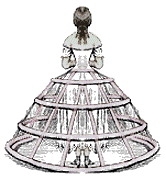
|
| Pantalets, Chemise, & Corset |
The Dressing Room was usually the lady's bedroom, but some higher class women had private dressing rooms
connected to their bedrooms where their servants, mothers, nannys, or sisters helped them dress each morning. It was a two-person
job to get dressed.
Women wore about 7 layers of clothing under their dress everyday. And YES,
women really did wear as many as 8 layers even in the hot, muggy, Southern weather!
UNDERPINNINGS
The 1st layer would be their Bloomers or Pantalets, which
were a light-weight pair of pants made of cotton that would come below the knee or to the ankle, depending on which they
were wearing. Normally, a younger lady (under 16) would wear those that would go to the knee, the more mature and
older women would wear them longer, to the ankles. Named after "Amelia Bloomer", they were baggy trousers which gathered
at the ankle, and were worn under a calf-length dress. Bloomers were most popular in the 1860s. Drawers
(sometimes mistaken for Bloomers,) were made of a thicker cotton or wool and were usually worn in the wintertime.
| Layer 1 & 2: Pantalets and Chemise |
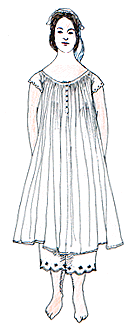
|
The 2nd layer would be the Chemise, sometimes also referred to as a Shimmy.This
was nothing more than a cotton night gown that would be worn under the corset to keep it from becoming soiled by bodily oils
and from pinching the lady. It also provided modest covering for a lady's true body form when a corset was not worn, such
as at bedtime.
The 3rd layer was the Corset. They were not used to get the very thin waistline,
or to give a woman a busty boost (this idea of thin-waist fashion came in the late 1800's.) Corsets were simply designed
so that it would give a smooth line from the waist to the bust of the woman and to support the many layers of hoopskirt, petticoats,
and day skirts worn by the lady. Corsets were constructed of whale bone (hence the term corset boning) or steam-pressed
wood sewn into cotton panels. There were hook and eye clasps or metal busks on the front and it laced up in the back.
The corset originated in France and spread throughout Europe and the United States. Modern corsets are made with metal busks
still, but mostly use metal or plastic boning.
Also called a Stay, the corset was considered to be the
most essential item of a Victorian woman's clothing. Laced tightly, the undergarment gave women a fashonably small waistline.
| Layer 3: Corset |
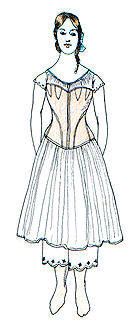
|
The 4th layer was the Under Petticoat, normally white, that was made of cotton.
It was worn under the hoop skirt (hence the term under petticoat) to keep it from getting dust and dirt blown up under it
and was worn to preserve modesty. The drawers/pantelets were split (for easier nightjar/out-house use) and any tilt of the
hoop or gust of wind could reveal more than she might wish to be seen! A petticoat also provided extra warmth in the winter.
| Layer 4: Under Petticoat |
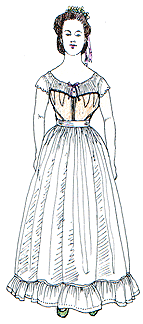
|
The 5th layer was the Hoop Skirt. Hoop skirts were sometimes made of whale
bone sewn into cotton, but were mainly constructed out of steel covered by cotton, making a simple caged crinoline. Some were
also made of cotton rope or hemp rope sewn into cotton panels (known as Corded Petticoats).This is what gave
the southern belles their bell-shape. Reproduction hoops for reenacting are made of steel or plastic and have more "give"
to them as
they are more flexible going through tight doorways than whalebone was.
| Layer 5: Hoop Skirt (or Corded Petticoat) |
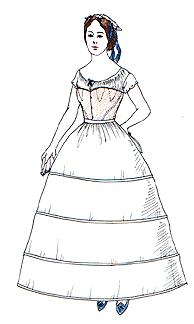
|
The 6th layer would have been the Corset Cover or Camisole was
made of cotton. It prevented the color of the dress from rubbing or fading onto the corset. Corsets were very hard to launder,
so they tried their best not to get anything on them by wearing a corset cover. Some corset covers were just as long as a
chemise, but others were merely to the waistline, long enough to cover the corset only.
The 7th layer were the Over Petticoats. They were worn over the hoop skirt (hence
the term over petticoat.) Normally, during the spring and summer a woman would only wear one or two of them. This was done
to hide the "hoops" in her hoop skirt so they would give her day skirt a smoother appearance. The purpose was to cover the
hoop skirt so that the "hoops" wouldn't show through It also prevented the "hoops" from getting rust on the lady's day skirt
should she be caught out in the rain by accident! During the Fall and Winter months, a lady would wear anywhere from
4 to 5 petticoats at a time for warmth.
| Layer 6 & 7: Over Petticoat and Corset Cover |
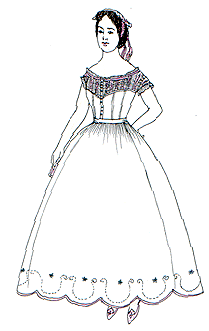
|
OUTERWEAR
Layer 8: Finally the Blouse or Day
Bodice and the actual Day Skirt.
The difference between a blouse and a bodice is that a bodice would fit snugly to the lady, the blouse was
loose fitting. Different skirts were worn for many reasons. A lady would have a work dress or skirt, to work in around the
house. There was no sense in messing up a perfectly good dress just for cleaning. She would also have clothes she would wear
around the house, saving her much nicer things for times when she would go to a friends house for visiting calls, into town,
carriage rides, tea time, special holiday
meals, etc.
If the weather was cold, she would add Petticoats under her skirt for warmth and wear a Shawl, Cape, or
Wool Coat over her dress.
A lady wore either a Bonnet, Straw Hat, or Ladie's Hat
when outdoors. This was a decree ordered by the Roman Catholic Church during medieval times that a woman's head must be covered
when outside or in Mass (church service). Even though the Church split between Roman Catholics and Protestants several centuries
earlier, ladie's were still required to wear a hat to cover their hair during the Victorian Era. Due to the difficult
upkeep of Victorian hairstyles and having to pin a hat to one's head, ladies were NOT required to remove
their hats when entering Churches, office buildings, stores, or a private home, while men were required out
of politeness and respect to remove their hats. This tradition of a lady's hat remaining on her head has followed us through
to current times where ladies are still not required to remove their hats, even when the National Anthem is played or US Flags
are present.
On Market Day, a lady would also wear an Apron or a Pinafore, also
know as a Pinner Apron. An apron tied around the waist, while a pinafore hung from the shoulders (pinned
with apron pins, hence the name Pinner) and actually covered most of the dress. This protected the lady's dress when
she approached dusty market booths full of fruits, vegetables, meats, and street dust kicked up from passing carriages
and buggies.
| Layer 8: Day Bodice and Day Skirt |
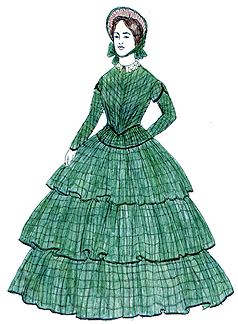
|
GLOVES:
Fashion etiquette mandated that women wear gloves when they went out in public--typically, white
tight-fitting kidskin gloves that were fastened buttons, or wrist gloves that at least covered the hands.
Gloves were not only worn by women, but by gentlemen as well. The reason was not for appearance (good looks),
but rather to keep the natural oils produced by human skin from contacting and soiling the dresses and suits. Clothing was
expensive and very difficult to wash, so all efforts were made to keep clothing clean. Gentlemen usually carried 2 or 3 pair
of gloves with them, should they dirty a pair with horse reins or before supper.
To learn more about Civil War Hairstyles click:
Civil War Hairstyles
|

